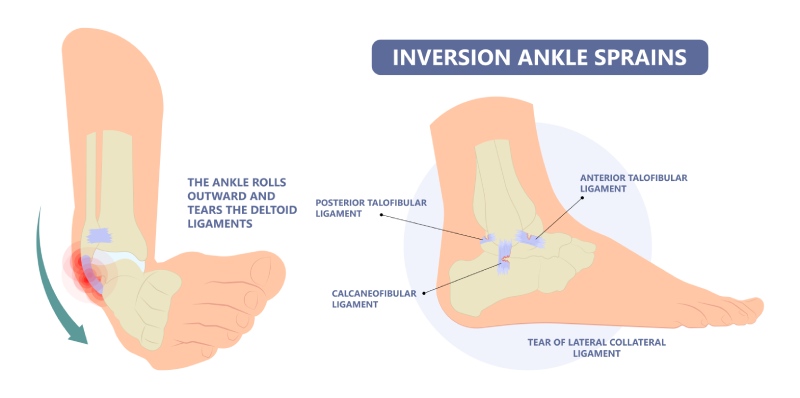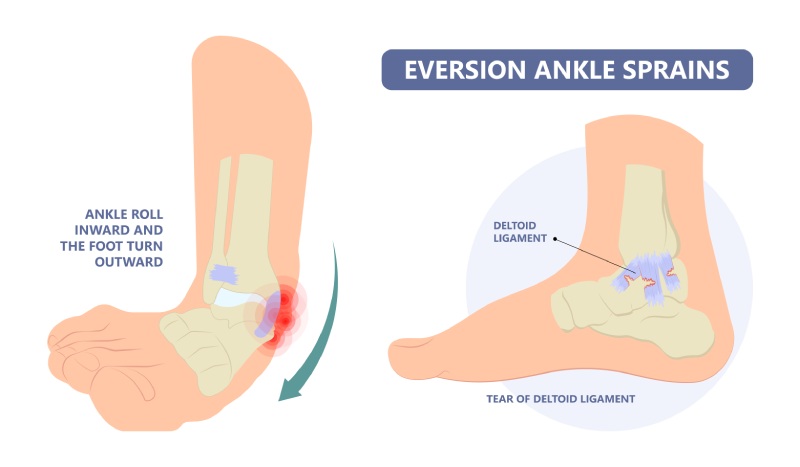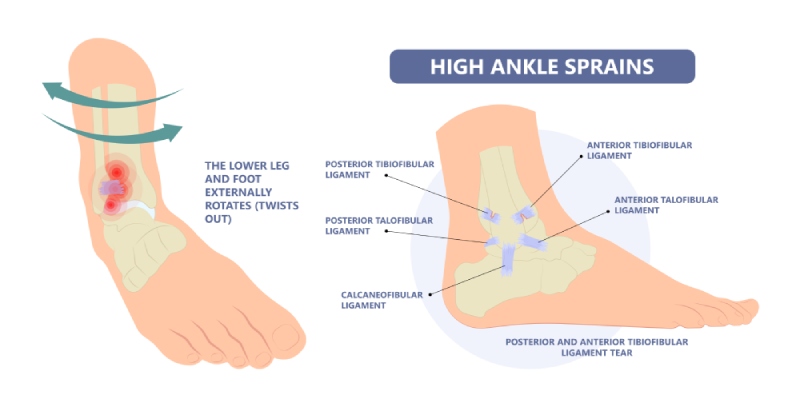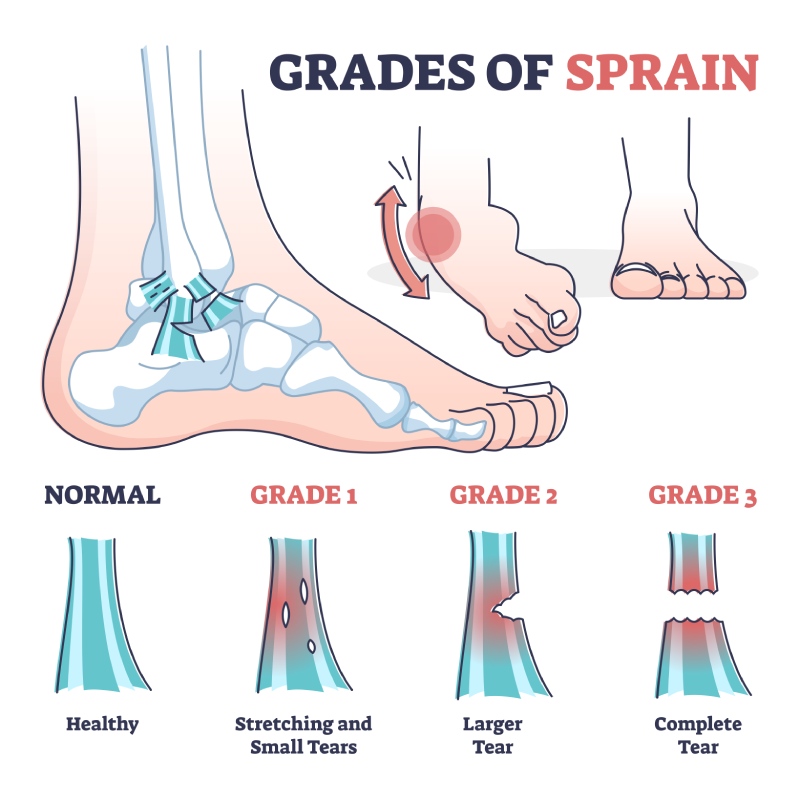Written by Dr Gowreeson Thevendran, MBChB (Bristol), MRCS.Ed, Dip. Sports Med.Ed, FRCS.Ed (Trauma & Ortho. ), FAMS (Singapore)
Symptoms of a Sprained Ankle
Sprained ankles result from ligament injuries within the ankle. These symptoms vary in intensity but commonly include:
- Pain: Immediate and ranges from mild to intense, especially when putting weight on the foot..
- Swelling: Fluid accumulation around the injury, often worsening hours post-injury.
- Bruising: Discoloration due to broken blood vessels around the ankle.
- Tenderness: Sensitivity to touch around the injured area.
- Limited Range of Motion: Difficulty moving the ankle, particularly in certain directions.
- Instability: A sense of wobbliness in severe cases, impacting standing or walking.
- Popping Sensation or Sound: May indicate a complete ligament tear.
If you experience intense pain, swelling that doesn't subside within a few hours, or any other symptom that concerns you, it's crucial to seek medical help.
Immediate Self-Care for Ankle Sprains
For immediate self-care, the RICE protocol (Rest, Ice, Compression, Elevation) is universally advised to alleviate pain and swelling:
- Rest: Essential for initial healing, avoiding further strain.
- Ice: Apply intermittently to reduce inflammation and provide relief. Use a cloth barrier to prevent skin damage.
- Compression: Use a bandage to support and stabilise the area, being careful not to impair circulation.
- Elevation: Helps reduce swelling by draining fluid away from the injured site.
Balance rest with controlled movement to prevent joint stiffness and muscle atrophy. Be mindful of limitations innate to self-care and consult a doctor for persistent or worsening symptoms.
Types of Ankle Sprains
Ankle sprains are categorised into three types based on the injury’s direction and location:
1. Inversion Sprains

Ligament Complex: Lateral Ligament Complex, including Anterior Talofibular (ATFL), Calcaneofibular (CFL), and Posterior Talofibular (PTFL) Ligaments.
Characteristics: Most often involves the ATFL, occurring during plantar flexion (downward movement) combined with inversion (turning the sole inward). CFL is more prone to injury during dorsiflexion (upward movement) with inversion. PTFL, the strongest, is less frequently injured.
Identification: Marked by pain on the outer side of the ankle, often with swelling and tenderness.
2. Eversion Sprains

Ligament Involved: Medial Deltoid Ligament.
Characteristics: Occurs with eversion, turning the sole outward. The Superficial Deltoid Complex limits excessive outward movement of the foot's top, while the Deep Deltoid Complex prevents excessive external rotation on the distal tibia.
Identification: Pain and swelling are noted on the inner side of the ankle. Though robust, injuries to this ligament warrant a specialist's evaluation due to its rarity and importance in ankle stability.
3. High Ankle Sprains

Ligament Complex: Distal Tibiofibular Syndesmotic Ligaments.
Characteristics: Involves ligaments stabilising the lower tibia and fibula. Less common but more prevalent among athletes. Typically results from substantial force causing external rotation or dorsiflexion of the ankle.
Identification: Pain is felt above the ankle, especially when squeezing the lower leg or rotating the foot. Due to the nature of the injury, professional assessment and treatment are essential.

Ankle Sprain Grading
Ankle sprains are graded based on severity and ligament damage:
1. Grade I Ankle Sprains
Ligament Damage: Stretching or microscopic tears in ligaments like ATFL and CFL.
Cause: Typically low-energy injuries with mild force applied to the ankle.
Symptoms: Mild pain, swelling, and tenderness, without joint instability. Weight-bearing is generally unimpeded.
2. Grade II Ankle Sprains
Ligament Damage: Partial tears of the ligaments.
Severity: More severe than Grade I, but not the most extreme.
Symptoms: Moderate pain, swelling, tenderness, mild to moderate joint instability. Noticeable discomfort when bearing weight or walking.
3. Grade III Ankle Sprains
Ligament Damage: Severe, often affecting syndesmotic structures (ligaments connecting the tibia and fibula).
Cause: High-energy injuries with significant force.
Symptoms: Severe pain, swelling, tenderness, bruising, and considerable joint instability. Marked loss of function and range of motion.
Ankle Sprain Treatment
Effective treatment varies based on the sprain's severity:
Treatment for Mildly Sprained Ankle (Grade I)
Approach: Rest and home care.
Actions: Apply ice regularly in the first 48 hours to reduce inflammation and discomfort. Use over-the-counter pain relievers for pain and swelling. Elevate the ankle during rest to minimise swelling.
Recovery Time: Typically heals in 1-3 weeks with proper rest and care.
Treatment for Moderately Sprained Ankle (Grade II)
Approach: Medical intervention with possible immobilisation
Actions: The doctor will typically recommend immobilising the ankle using a brace, splint, or walking boot. This measure stabilises the ankle and limits its range of motion to facilitate the crucial early stages of healing.
Alongside immobilisation, engaging in physical therapy may be critical for moderately sprained ankles. Skilled professionals can design personalised exercise programmes to restore the ankle's range of motion, strength, and flexibility. These exercises are vital to prevent joint stiffness, muscle atrophy, and chronic instability during the recovery process.
Recovery Time: Typically 3-4 weeks with proper care and support.
Ankle Sprain Surgery
Treatment for Severely Sprained Ankle (Grade III)
For severe sprains or complete ligament tears, surgery may become a necessary course of action, especially when other treatments have not yielded successful outcomes. Such surgical procedures are focused on repairing the ligaments to restore stability and functionality to the ankle joint.
Following surgery, engaging in a structured rehabilitation programme is crucial for the patient to regain strength and mobility in the sprained ankle. The complete healing process from such surgical interventions can vary, typically ranging from three to six months, depending on individual healing rates and adherence to rehabilitation protocols.
Recovery Period for Ankle Sprains
The recovery duration for a sprained ankle varies, influenced by the injury's severity and the individual's treatment response. This process involves distinct rehabilitation stages, each critical for a full and safe return to daily activities or sports.
1. Acute Stage
The acute stage immediately addresses pain and swelling. Techniques include applying external pressure and cryotherapy. This stage also introduces active range-of-motion exercises to manage pain and prevent stiffness, laying the foundation for subsequent recovery phases.
2. Subacute Stage
In the subacute stage, the focus shifts to maintaining the ankle's range of motion and preventing muscle atrophy. This stage integrates range-of-motion and gentle strength-building exercises, ensuring the ankle retains its flexibility and mobility.
3. Intermediate Stage
The intermediate stage prioritises proprioception, enhancing the ankle's sense of position. Exercises in this stage target balance, coordination, and joint stability, aiming to correct postural imbalances and avert future instability.
4. Advanced Stage
The advanced stage marks the transition to more physical and sport-specific activities, tailored to the individual's specific requirements. This stage's duration can vary, with some individuals returning to full activity relatively quickly, while others, especially those with more extensive damage, may experience a longer recovery with persistent stiffness and discomfort.
Overall healing can extend up to 12 weeks, with complete ligament healing and restoration of structural integrity. Throughout the recovery process, consulting with a healthcare professional ensures the rehabilitation plan is aligned with the unique needs of the individual's ankle sprain.

Dr Gowreeson Thevendran
Orthopaedic and Trauma Surgery Specialist in Singapore with 15+ Years Experience
Dr. Gowreeson Thevendran is a fellowship-trained orthopaedic surgeon specialising in minimally invasive techniques for the foot, ankle, knee, hip, and thigh, as well as in trauma and fracture surgery. With his extensive training from the UK to Canada, he is a leader in both the operating room and global orthopaedic education.
Why Do Patients Choose Dr. Gowreeson Thevendran?
Fellowship-trained in foot & ankle surgery, sports surgery, and complex trauma.
Fluent in English, Malay, and Tamil, allowing for diverse patient communication.
Expertise in minimally invasive surgical techniques.
Specialises in comprehensive lower limb orthopaedics and trauma surgery.
Recipient of multiple awards, including the SICOT PIONEER Founders Award.
Chair of the Education Academy of SICOT, enhancing global orthopaedic education.
Introduced Magnezix bioabsorbable screws in Singapore, leading advancements in surgical materials.
Renowned for his scientific contributions and roles as an international faculty member.
Committed to detailed aftercare plans for long-term patient recovery.
Part of Healthway Medical Group, offering convenience and excellence in orthopaedic treatment.
Frequently Asked Questions about Sprained Ankle Treatment in Singapore
Ankle sprains occur when the ligaments that support the joint stretch beyond their limits or tear. This often happens during physical activities when the foot lands awkwardly, twisting the ankle. Common causes include sports injuries, uneven ground, or accidental slips.
Symptoms like pain, swelling, and difficulty walking signal a sprain. Always seek professional treatment to prevent further injury and ensure proper healing.
In Singapore, sprained ankle treatments are typically covered by insurance and Medisave. Coverage can vary, so it's important for patients to check with their clinic and insurance provider. OrthofootMD can assist patients in understanding their eligibility for claims and the coverage extent for their treatment.
Similar to hip replacement and flat foot surgery, ankle sprain surgery, though often effective, may carry risks like infection, bleeding, or reactions to anaesthesia. Post-surgery, patients might also experience discomfort from immobilisation, such as itching or sweating under a cast. Medications for pain and inflammation can have side effects as well, including an upset stomach and slight dizziness.
Following a surgeon's aftercare instructions can minimise these risks. Always discuss potential complications with your doctor before surgery.
Clinic Location
OrthofootMD@Novena
- Mount Elizabeth Novena
38 Irrawaddy Road #05-42 Mount Elizabeth Novena Specialist Centre Singapore 329563
OrthofootMD@Mount Alvernia Hospital
- (Mount Alvernia Hospital)
820 Thomson Road #01-01/02 Mount Alvernia Medical Centre A Singapore 574623